Types of aquarium plants
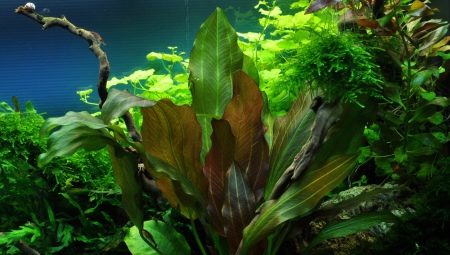
An aquarium is something that can revitalize and decorate the interior. Plants play the main aspect in its design. If the flora in an artificial reservoir is formed correctly, then this is not only a guarantee of aesthetic appeal, but also the health of the biosystem.
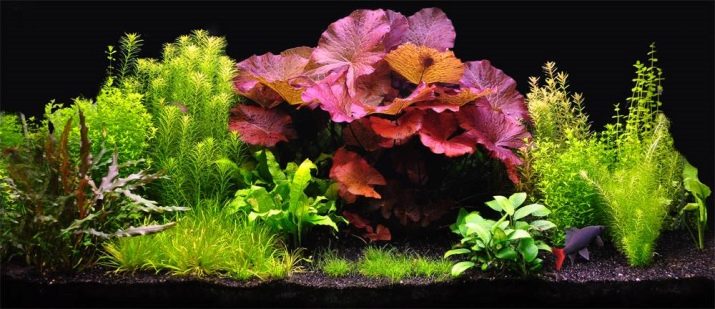
What are they needed for?
Plants in an aquarium are considered light. Similar to vegetation on land, aquatic vegetation absorbs CO2, while producing oxygen and saturating the water column with it. In addition, aquarium plants qualitatively neutralize the waste products of fish, cope with nitrates and phosphates. Provided the correct selection of aquarium flora and its proper placement, you can count on the biological balance of the system, as well as maintaining the required volume of O2 in the water.
Aquarium flora can be considered the best water indicator in an aquarium. Plants that are characterized by their lushness, beauty and vibrant color are indicative of a healthy world in the reservoir. Vegetation is very important for the fauna that live in an artificial reservoir. It can serve as a home for them, additional food, refuge and spawning grounds.
Aquarium plants are an essential element in a fish tank, as well as a guarantee of a clean and healthy ecosystem.

Main classification
Today there is a wide variety of aquarium vegetation. In order for different species to get along well with each other, you will need to place them correctly and take care of them.
All aquarium vegetation can be divided into the following groups:
- existing at the bottom of the tank or near a water surface; an example of this group would be Bryophytes;
- floating freely in the water column or near its surface; often these representatives of the flora are fixed in the soil, they include the Puzyrchatkovs, Rogolistnikovs, Rosyankovs, Ryaskovs;
- floating freely on the surface - these are Azolla, Vodokrasovye, Pontederiyevye, Salvinievye;
- growing at the bottom, blooming under water - these include Naiad, Zanikelyevs; some representatives can carry a flower stem with a flower to the water surface, for example, Vallisneria, Water buttercup, Urut;
- grow in the substrate, forming leaves and flowers - these are Water Lily, Aponogetone;
- swamp and coastal representativesthat rise quite strongly above the water surface; an example of this group of plants are Aroid, Sedge, Echinodorus.

Depending on the planting area, aquarium vegetation is divided into the following types:
- foreground (anubias, water buttercup, bucephalandr, marsilia, blixa, glossostigma, mosses and others);
- middle ground (cryptocoryne, kabomba caroline, anubis, ludwigia, rotala, echinodorus);
- background - these are tall long-stemmed plants (hornwort, alternantera, aponogeton, bacopa).
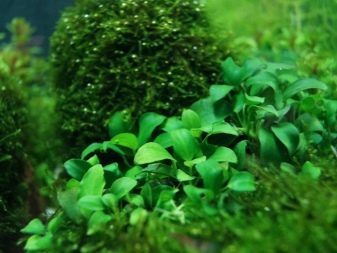
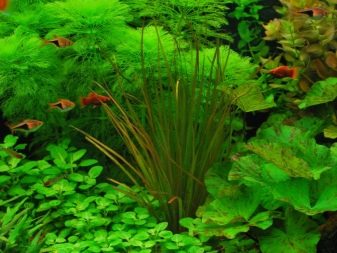
Flowering varieties
Aquarium plants are not always algae, they often include higher flowering representatives that have adapted to life in the aquatic environment. These specimens bloom, but this process happens quite rarely in artificial ecosystems.
Let's take a closer look at the names and descriptions of common flowering aquarium plants.
- Sagittaria... This plant is considered an arrowhead from the Chastukhov family. The specimen is represented by bright green foliage that looks like a bush. Sagittaria is characterized by unpretentiousness, ease of reproduction, as well as an attractive appearance. The rhizome of the plant is white, tuberous, nodular in shape. The foliage is braid, sometimes petiolate. The color of the juicy leaves is rich green. The flowers are composed of broad white petals. Keeping this type of vegetation is quite simple, as the arrowhead thrives in alkaline and hard water.
Arrowhead prefers a fine-grained substrate that is rich in nutrients.
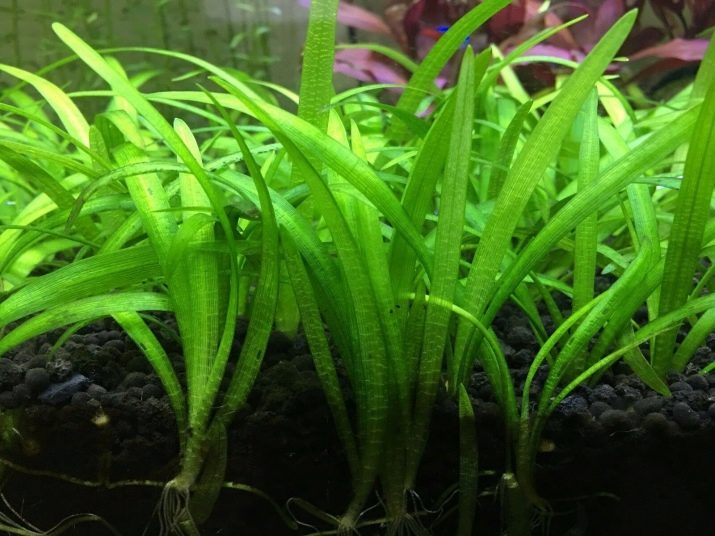
- Krinum... This representative belongs to the Amaryllis family, so it can live both on land and in water. He has an excellent ability to adapt to different environmental conditions. Krinum has long, dense, narrow foliage that can reach 200 centimeters. According to many aquarists, the flowers of this specimen are the most beautiful of their kind. Usually shoots with flowers come out of the water surface, their color can be very different. The popularity of krinum is due to its unpretentiousness, as well as longevity.
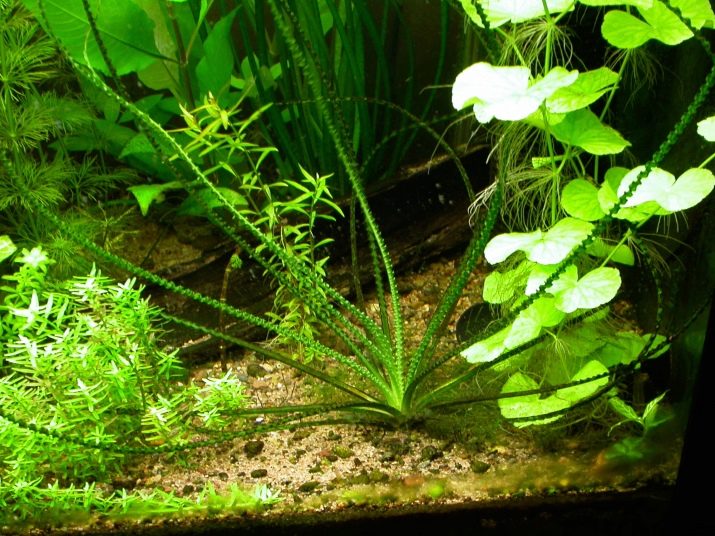
- Limnobium... This representative of the vodka family is also called Canadian Elodea, Vallisneria vulgaris. The plant belongs to floating on water, it can be presented in the form of a shoot and a spongy plant. The representative of the flora grows throughout the year, it is often used as shading for other inhabitants of the reservoir. Limnobium can grow rapidly under the right conditions. By cleansing water from suspended matter and filtering it, elodea canadensis is beneficial for the aquarium.
This representative of the flora is unpretentious, it can grow at any acidity, but in the temperature range from 20 to 30 degrees Celsius.
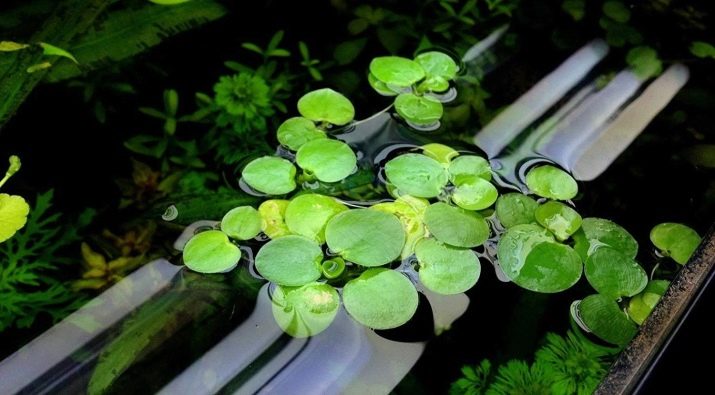
- Lobelia purple... It is large in size and is often raised by experienced aquarists. However, there are also dwarf forms that are easier to care for. This plant belongs to long-stemmed, has an olive-green color.The oval foliage is arranged alternately, its upper part is colored light green, and the lower part is reddish. The root system is poorly developed. The name of the lubelia is derived from the presence of purple flowers that are released when semi-submerged in water.
This representative of the flora should be planted along the side aquarium walls in the background.
For normal life, he needs regular water changes, temperatures from 22 to 26 degrees above zero and hardness in the range from 5 to 15. Low light can cause yellowing of the plant.
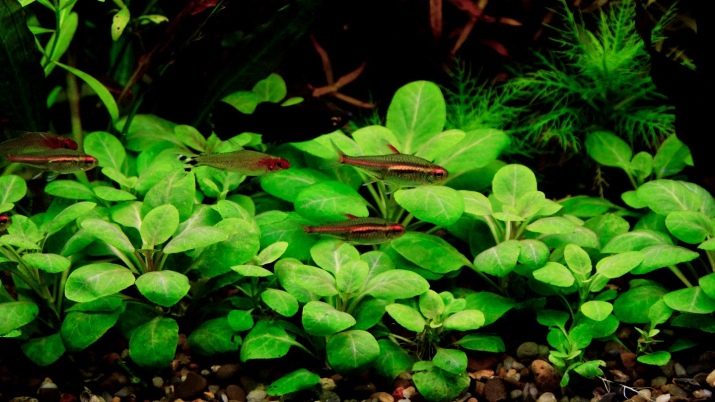
- Rotala Indian... It is a small-flowered angiosperm plant. This round-leaved representative of the flora can have several varieties, which differ from each other in the number of foliage in whorls. The rotala has a long stem, it can reach about 0.2 meters. The leaves are green with a bright bottom. This beautiful plant has the ability to decorate the aquarium with its presence. Aquarists do not have to make much effort and spend a lot of time growing rotala.

- Cinema... Demorphic hygrophilus is recognized as one of the most popular aquarium plants. This is a long-stemmed, unpretentious representative of the flora, which is characterized by a decorative appearance. Cinema normally develops in both acidic and hard water. Fast-growing hardy plant grows to a height of 0.3 meters. Its foliage is similar to fern, it is painted in a rich green color.
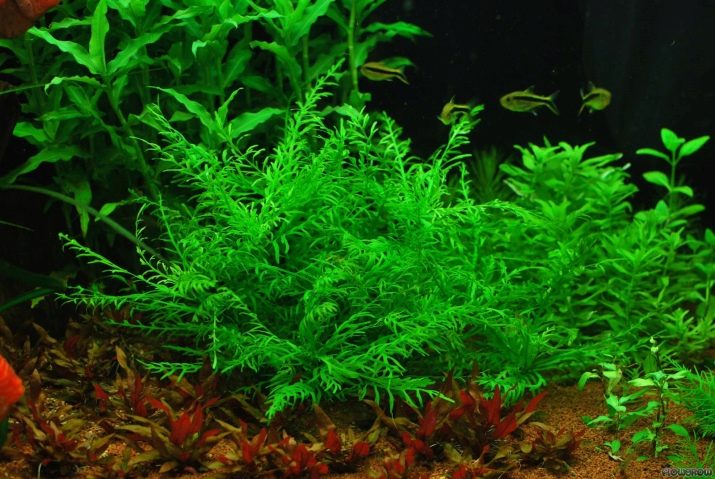
- Limnophila... It is generally recommended for beginner hobbyists. This is an unpretentious and very beautiful representative of the flora. Fluffy limfonila twigs have some similarity with openwork balls, which are painted in a juicy green color. The herb is characterized by a long, erect stem. Sessile-flowered lymphoid can exist at temperatures from 18 to 30 degrees above zero and a water hardness of 6 to 12.
The optimal place for growing this aquarium plant is considered to be a spacious aquarium with a slightly acidic or slightly alkaline environment.

- Micrantemum "Monte Carlo" characterized by the presence of long roots that are able to grow into the soil without floating to the surface. The diameter of the foliage of this plant is about 3 millimeters. Planting this specimen in an aquarium is a guarantee of the natural appearance of the ecosystem. Micrantentemum does not require intense lighting and a high concentration of fertilizers. During the growth phase, the plant forms a dense mat, which is able to take root on a stone or driftwood.
This simple light green plantation is usually planted in the foreground of the aquarium.
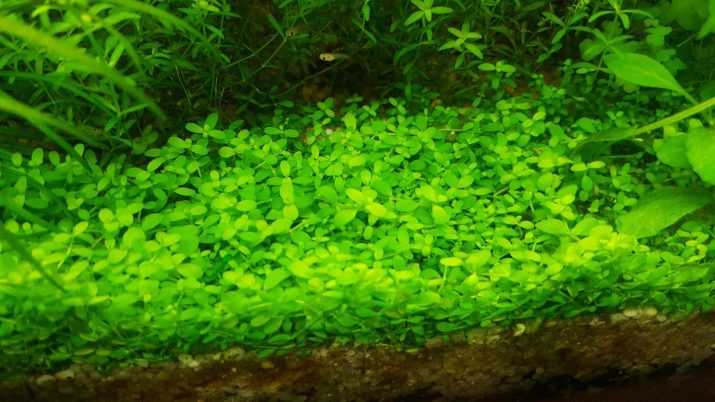
- Naiad... This plant is considered a persistent and unpretentious representative of the flora, which is capable of forming dense thickets. For this reason, it can be advantageously used for fish spawning and as a substrate. The nayas has no special decorative qualities.
The optimum temperature for a plant is considered to be from 18 to 30 degrees Celsius. In very soft water, the development of the specimen may slow down.
The stem of the fine-toothed naiad is characterized by thinness and branching, in length it can reach about 100 cm. The foliage is oblong, green or reddish, 4 cm in size. The edges of the leaves are framed with small thorns.
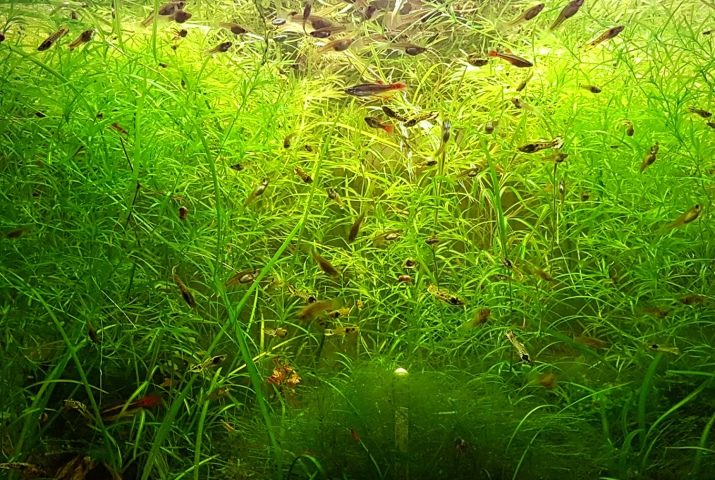
- Pennywort... Hydrocotyl is considered a moisture-loving member of the umbrella family. Its main characteristics include rapid growth and unpretentious content. This plant is used as an ornamental plant for an aquarium and the coast of a reservoir. Such a bright lawn has the ability to protect fish from the harm of sunlight and shelter fry that are unable to protect themselves. Thyroid has a long stem, about 50 centimeters long. The foliage is round, light green, with a diameter of 4 centimeters. The leaves have some similarities with water lilies.During the flowering phase, the plant is covered with small white flowers.
In the conditions of an artificial ecosystem, hydrocotyl needs special care and maintenance.
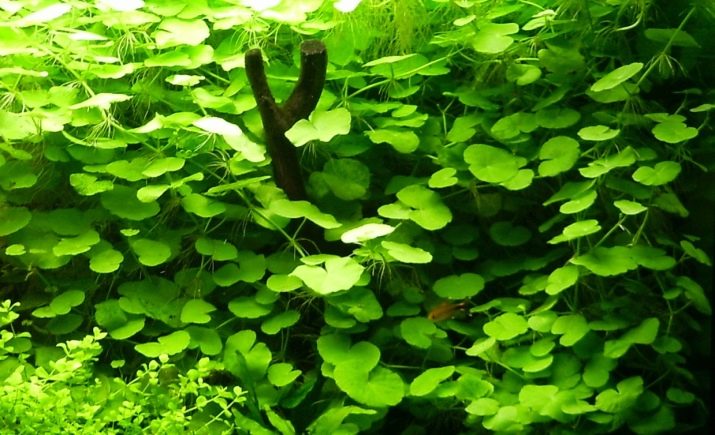
- Mexican oak or trichocoronis is an unpretentious plant that, under optimal conditions for it, can grow and become a stunning background in the aquarium. The Mexican oak has a stem, light green oval leaves, no more than 10 millimeters long. Reaching the water surface, this representative of the flora can bloom with white flowers. Trichocoronis is characterized by rapid growth, therefore it needs pruning.
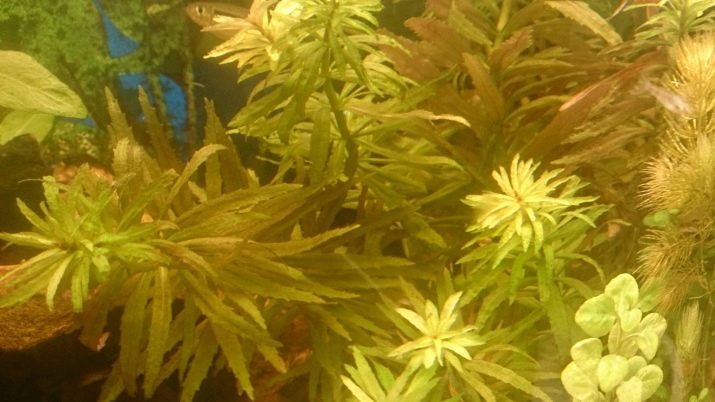
- Alternantera... This plant is popular with aquarists, as it is an outwardly attractive long-stemmed specimen. Its foliage is colored in vibrant shades, ranging from pink to dark purple. Alternantera lashes spread along the water surface, as they are long. This representative of the flora is able to grow throughout the year. If the plant is completely immersed in liquid, then its growth slows down.
The best option for keeping alternantera is a tropical aquarium with a water temperature of 24 to 28 degrees Celsius. For normal life, she needs a regular change of water.

- Hemianthus Cuba - This is the most popular ground cover inhabitant of aquariums. It is considered a worthy part of an underwater lawn. As it grows, Hemianthus cube is able to form dense green carpets that adorn the bottom of the aquarium. Plant height can reach 3 to 6 centimeters.
This representative of the flora is capricious, as it needs enhanced lighting and a regular supply of CO2.
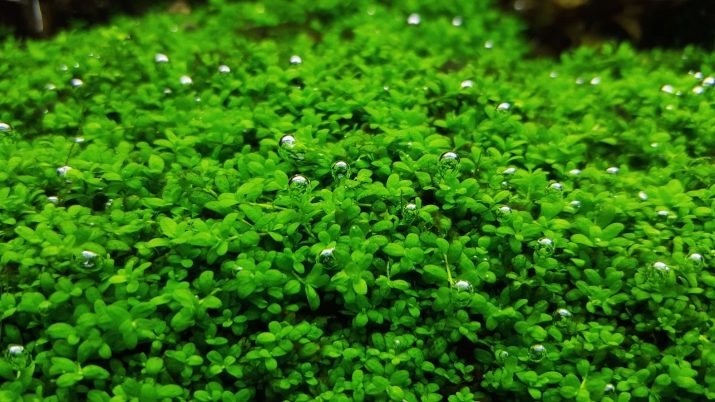
- Hydrocotyl tripartite... It is a popular aquarium flora and is widely used in aquarium decoration. Growing, the plant creates a dense green carpet. It is often used to decorate the middle of the aquarium.
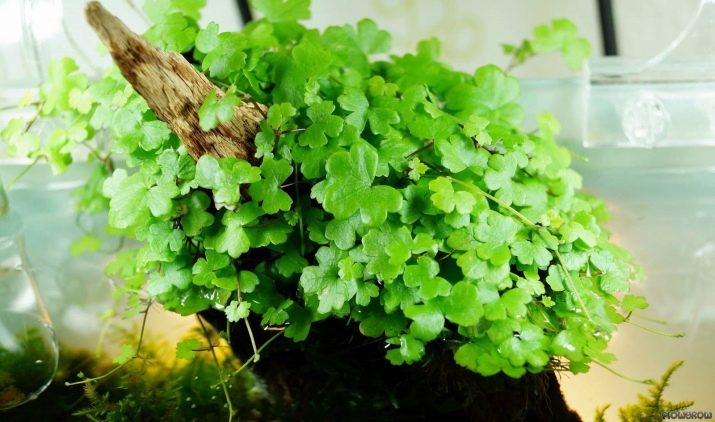
Fern plants
Aquarium ferns are considered one of the most beautiful, therefore popular plantings in artificial ecosystems. This type of vegetation is a wonderful shelter for aquarium inhabitants, as well as an additional source of oxygen.
Ferns are considered unpretentious representatives of the flora, which do not require special care measures, but at the same time decorate the reservoir with their presence.
The description of these plants indicates that they perfectly adapt to existence in an artificial reservoir.
Let's take a look at the most common ferns.
- Marsilia Krenata... This type of plant requires planting in the depth of the substrate. On the stem of the fern, there are many small twigs with leaves up to 30 millimeters in size. The bright green color makes Marsalia a real ecosystem decor. This representative of the flora grows well, being completely immersed in water, and also does not show whimsy to the hardness and acidity of the liquid. However, he prefers to exist in low light conditions.
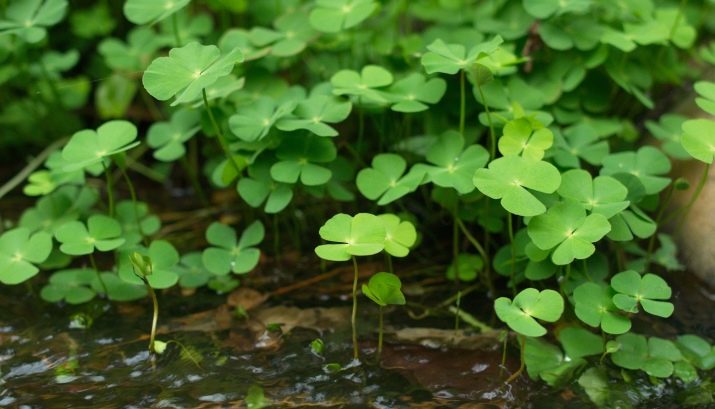
- Bolbitis characterized by a stem that grows horizontally. For this reason, the leaves of the plant have an unusual horizontal arrangement. The stems and petioles of the foliage are covered with golden scales, due to which the fern looks very beautiful. The length of bolbitis usually reaches 0.6 meters, while each leaf can be about 20 centimeters thick. The leaf is hard, pinnately complex with a dark green or neon color. For good plant survival and normal growth, the roots should not be immersed in the soil.
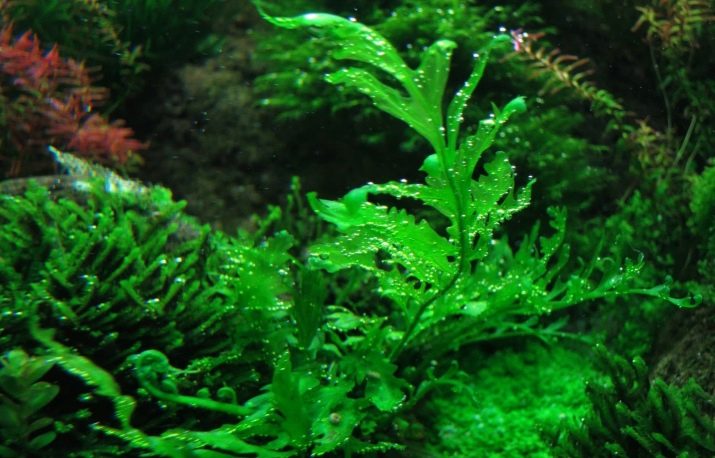
- Azolla carolina... The fern is able to thrive well on the water surface. Several plants collectively cover the surface with a carpeted floor. The stem of the fern has fragile and delicate foliage. The parts that are above the water are blue-green in color, while those submerged in the water are pinkish-green.The fern is capable of developing exclusively in the warm season, in winter it hibernates.

- Lomariopsis... It is a common aquarium plant that consists of a thin thallus. The petals are wide with a round shape. The fern consists of a transparent, dark green fabric. Lomariopsis is considered an undemanding plant that does not make it difficult to care for.
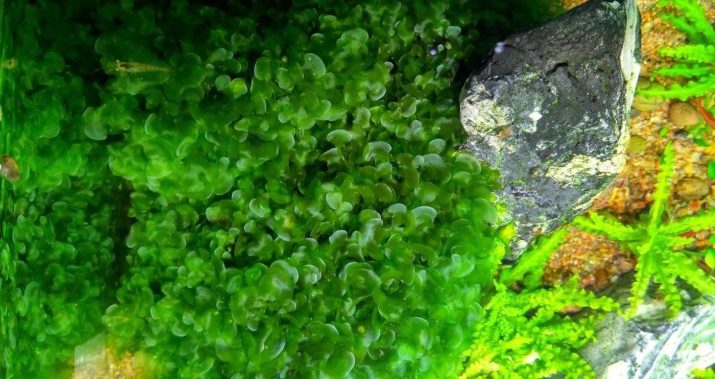
Popular algae
Aquarium algae are considered to be the simplest plants. They come in a wide variety of sizes, shapes and colors.
Algae in the aquarium can be of the following types:
- floating on the water surface;
- those that are attached to the substrate.
In addition to harmful algae such as black beard, diatoms, green spots, tufts, beautiful specimens can also be found in artificial ecosystems.
- Vallisneria giant... This is a large type of algae that should be kept exclusively in a large aquarium. Planting the plant should be carried out near the back wall. Vallisneria is characterized by a rich dark green color.
For a normal existence, she needs a bright light and a nourished substrate.
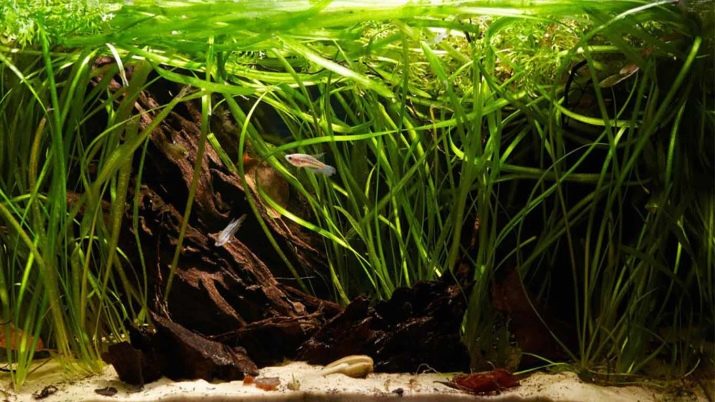
- Riccia... It is a floating algae that thrives in moderately warm water. The plant is often used as a spawning substrate for fish breeding and for hiding their fry. Increased water hardness can cause algae to grow slowly. The optimal temperature for Riccia is considered to be plus 22 degrees.
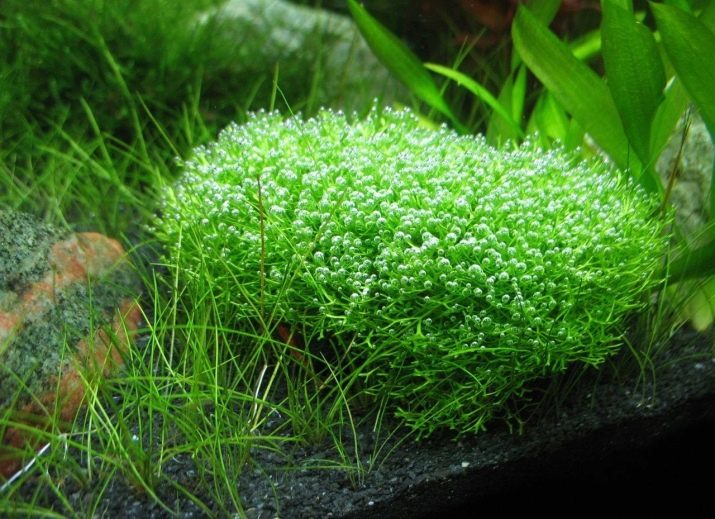
- Submerged hornwort... This type of algae belongs to perennials. It floats on the water surface as it has no roots. The stem of the plant is long, needle-like and rather small. This algae is considered ideal for aquarium keeping, usually fry are hidden in it. Hornwort loves bright lighting and thrives in moderately warm to cold aquariums.
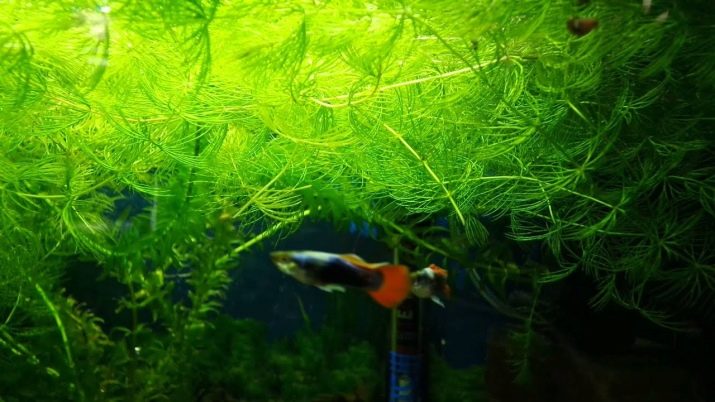
- Spherical cladofora is a decorative representative of a freshwater aquarium. The structure of the plant is made up of green filamentous algae that intertwine and form into a dense ball. In an artificial ecosystem, a plant can grow up to 6 centimeters. In an aquarium, the cladophore should be placed at the bottom, where it emits O2 in the morning. Algae should be kept in cool water with a temperature of about +20 degrees.

Variety of mosses
Today, you can find a lot of home aquariums dominated by mosses. Such popularity is based on bright decorative qualities, lack of whimsical care, as well as a wide variety of species. The use of mosses is an opportunity to embody various ideas in the form of beautiful landscapes of the underwater kingdom.
Aquarium moss can be of the following classes:
- anthocerot with lamellar thallus;
- hepatic, which is characterized by tenderness and small size;
- leafy is considered the most numerous class.
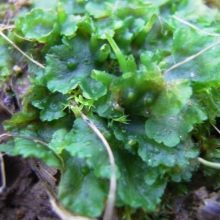
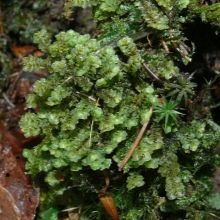

Most often, aquarists grow multiple plants in their ecosystems.
- Triangular moss... This plant is characterized by beauty and unpretentiousness. It is represented as a green equilateral triangle. This moss grows well into the substrate and has average growth rates.
- Moss flame... The originality of this representative of the flora lies in the fact that it grows in an undulating manner and exclusively in a vertical direction, resembling a flame. Among other mosses, it is distinguished by a more intense green color. The flame has found its application in the formation of a "forest landscape", it is considered an excellent option for both the background and for the central plan.
- Phoenix... This moss looks like a frozen fountain. Its growth is concentrated from the center in different directions. Its use is a worthy imitation of a bump in a tank. Phoenix grows slowly, but at the same time it grows tightly to stones and snags.
- Javanese moss recognized as the most common.It is characterized by undemanding lighting, water performance and maintenance. It can grow outside the substrate, namely on driftwood, stone and any other surface.
- Christmas moss no less popular among aquarists than the previous one. It has a branched herringbone structure. The plant is also characterized by unpretentiousness.
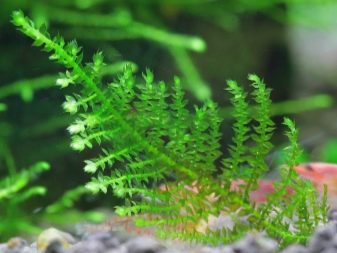
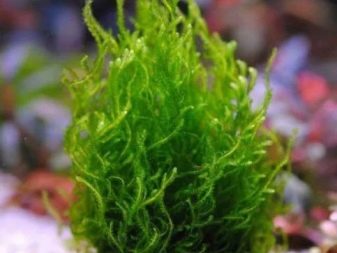
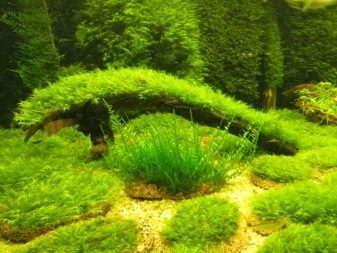
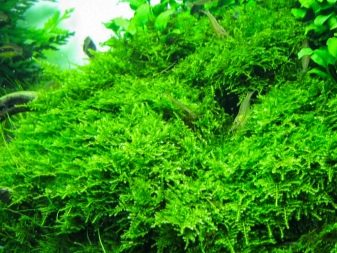
How to choose?
After buying an aquarium, the owner of the aquarium is faced with the question of what kind of vegetation to plant in it. And this is not surprising, because it is not so easy to determine whether these are red or green plants, rare or widespread, meristemic or undersized. However, accidents should remember one thing - for beginners, unpretentious plants will become the best options.
Already after a person has gained experience in this direction, he can proceed to vegetation with difficulties in care.
The following vegetation will be a worthy option for a novice aquarist:
- duckweed, riccia;
- hygrophilia;
- hornwort;
- echinodorus;
- mosses of various types;
- anubias.
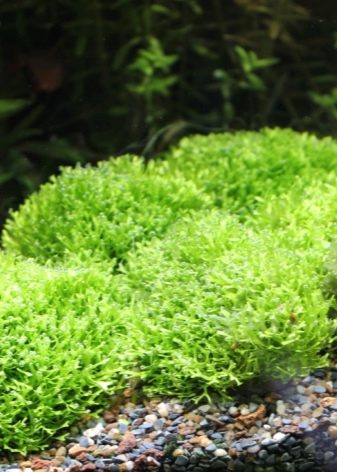
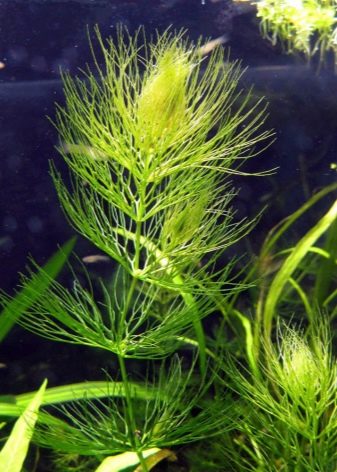
For hard water
Some plants do not show whimsical water indices and can grow and develop normally in hard water. The most common representatives of the flora who love these conditions include Cryptocorynes, Anubis, Javanese moss.
Shade-loving
Plants in an aquarium do not always need a lot of light to grow well. Some representatives of the flora carry out normal activities in shade conditions.
- Anubis Barter... This plant is considered one of the most beloved by aquarists, as it does not pose any difficulties in care. It can grow over a wide temperature range. Its bright green leaves look great in the background and foreground of the tank.
- African aquatic fern is an excellent option for a medium sized aquarium. For normal development, the plant needs warm fresh water and low light. It cannot be grown in an ecosystem that is home to goldfish, koi, cichlids.
- Java fern characterized by wide green foliage sticking out in the water column. This is a worthy option for beginner hobbyists, as it can grow in water of any temperature or condition, and it doesn't need a lot of light. Java's growth is slow, the maximum height can be 0.35 meters.
- Green Hygro... The green hardy representative of the flora is characterized by fast growth rates, therefore it needs to be pruned.
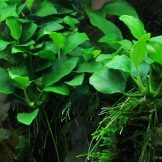
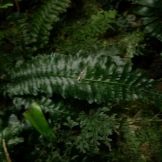
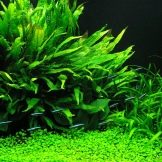

Fast growing
When launching a new aquarium, it is recommended to plant fast-growing flora in it. Such specimens absorb organic matter from the water, while forming a biological balance. Fast growing aquatic vegetation is often unpretentious.
The most common inhabitants of aquariums include vallisneria, canadian elodea, variegated hygrophila, yellow cryptocoryne, lemongrass, aponogeton.
More about the types of aquarium plants in the next video.








